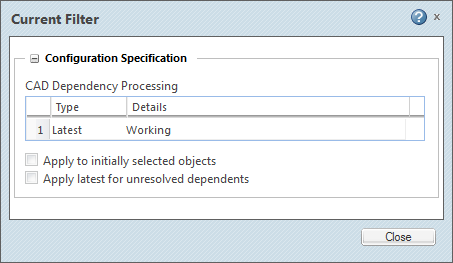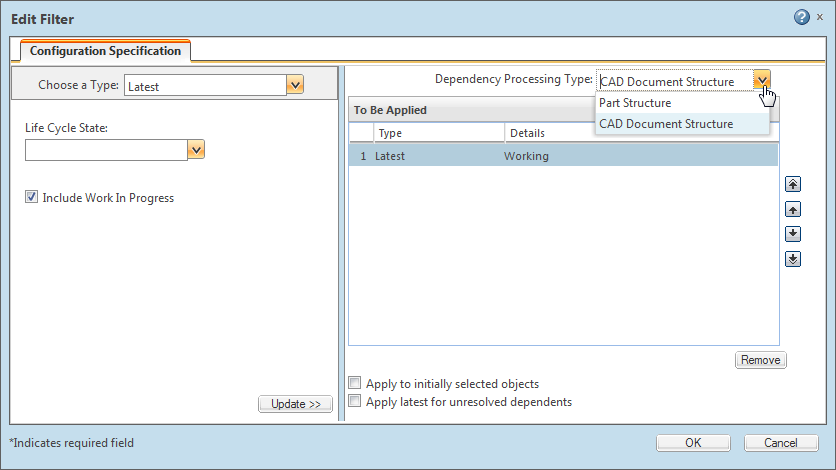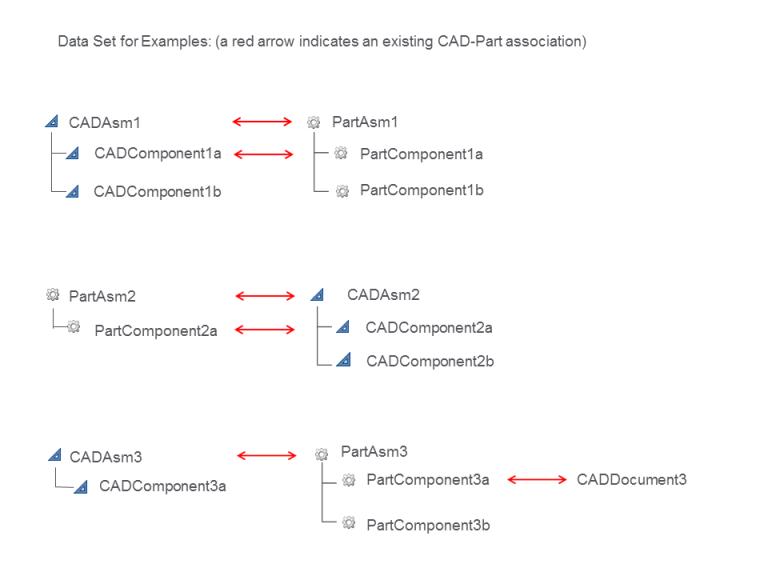You can see the type of dependency processing specified for the current action page by clicking the current filter icon  to open the Current Filter window, seen in the following figure showing CAD Dependency Processing.
to open the Current Filter window, seen in the following figure showing CAD Dependency Processing.
|
Initially Selected Objects
|
Default Dependency Processing
|
|
CAD documents
|
CAD Dependency Processing
|
|
Windchill parts
|
Part Dependency Processing
|
|
Windchill documents
|
Document Dependency Processing
|
|
Mixed set of objects containing one or more CAD documents
|
CAD Dependency Processing
|
|
Mixed set of objects containing one or more parts and no CAD documents
|
Part Dependency Processing
|


Even though the default setting for Enable Dependency Processing Type is false, all PDM actions that use the collector collect with dependency processing enabled, as described by the preceding table. |
When a workspace specification has dependency processing set to part centric, a CAD document is considered out-of-date if the version in the workspace does not have an association link to the part version included in the specified baseline for parts. |

Initially Selected | Dependency Processing Type | Dependents Setting | Resulting Object List | Comments |
CADAsm1 | CAD Document Structure | CAD document: All | CADAsm1, CADComponent1a, CADComponent1b | Collection traverses the CAD Document (EPMDocument) structure. |
CADAsm1 | Part Structure | Part: All | CADAsm1, CADComponent1a | 1. Dependency processing type is Part Structure. Initially selected CADAsm1's associated object PartAsm1 is traversed. 2. CAD documents associated to dependents of PartAsm1 are collected. 3. The collector returns the initially selected CADAsm1 and CADComponent1a as an associated object to PartComponent1a (not as a dependent of CADAsm1). |
CADAsm1, CADAsm2 | Part Structure | Part: All | • CADAsm1, CADComponent1a • CADAsm2, CADComponent2a | 1. Dependency processing type is Part Structure. CAD documents associated to dependents of PartAsm1 and PartAsm2 are traversed 2. CAD documents associated to dependents of PartAsm1 and PartAsm2 are collected. 3. The collector returns the initially selected CADAsm1 and CADAsm2, plus CADComponent1a and CADComponent2a as associated objects to PartComponent1a and PartCompponent2a, respectively (not as dependents of CADAsm1 and CADAsm2). |
CADAsm3 | Part Structure | Part: All | • CADAsm3 • CADDocument3 | 1. Dependency processing type is Part Structure. Initially selected CADAsm3's associated object PartAsm1 is traversed. 2. CAD documents associated to dependents of PartAsm3 are collected. 3. The collector returns the initially selected CADAsm3, and CADDocument3 as an associated object to PartComponent3a. |
PartAsm3 | CAD Document Structure | CAD document: All | PartAsm3 | Dependents of associated CAD document have no associated parts. |
Initially Selected | Dependency Processing Type | Dependents Setting | Results | Comments |
CADAsm1, PartAsm2 | CAD Document Structure | CAD document: All | • CADAsm1, CADComponent1a, CADComponent1b • PartAsm2, PartComponent2a | 1. Dependency processing type is CAD Document Structure. Initially selected PartAsm2's associated object CADAsm2 is traversed; and initially selected CADAsm1 is traversed 2. Parts associated to dependents of the CADAsm2 are collected; and dependents of CADAsm1 are collected. 3. The collector returns the initially selected objects(CADAsm1, PartAsm2) and CADAsm1 dependents (CADComponent1a, CADComponent1b). Plus, the parts associated to the dependents of CADAsm2 are returned. |
CADAsm1, PartAsm2 | Part Structure | Part: All | • CADAsm1, CADComponent1a • PartAsm2, PartComponent2a | 1. Dependency processing type is Part Structure. Initially selected CADAsm1's associated object PartAsm1 is traversed; and initially selected PartAsm2 is traversed. 2. CAD documents associated to dependents of PartAsm1 are collected; and dependents of PartAsm2 are collected. 3. The collector returns the initially selected (CADAsm1, PartAsm2) and the PartAsm2 dependents (PartComponent2a). In addition, the CAD documents associated to the dependents of PartAsm1 (CADComponent1a) are returned. |
CADAsm1, PartAsm3 | CAD Document Structure | CAD document: All | • CADAsm1, CADComponent1a, CADComponent1b • PartAsm3 | 1. Dependency processing type is CAD Document Structure. Initially selected PartAsm3's associated object CADAsm3 is traversed; and initially selected CADAsm1 is traversed. 2. Parts associated to dependents of CADAsm3 are collected; and dependents of CADAsm1 are collected. 3. The collector returns the initially selected objects (CADAsm1, PartAsm3) and CADAsm1’s dependents (CADComponent1a, CADComponent1b). There are no objects associated to CADAsm3 dependents, so no additional parts are returned. |